Every 40 seconds, a stroke strikes in the US. Every 4 minutes, it claims a life. With nearly 800,000 cases every year¹, stroke is a silent predator, often striking without warning.
But what if you could spot the danger before it hits?
Recognizing the early signs of stroke can mean the difference between full recovery or long-term disability. This guide equips you with critical knowledge to identify stroke symptoms and take preventive measures.
From sudden numbness to unexpected vision problems, we’ll explore the red flags your body might be waving. You’ll also learn about different types and signs of stroke, common risk factors, and steps to protect you or a loved one.
What is a Stroke?
A stroke happens when blood flow to the brain is blocked or reduced, causing brain cells to die. There are two main types of strokes:
- Ischemic Stroke: This is the most common type, occurring when a blood clot blocks or narrows an artery leading to the brain.
- Hemorrhagic Stroke: This occurs when a blood vessel in the brain bursts, leading to bleeding in or around the brain.
Both types of strokes can have serious and potentially life-threatening consequences. Quick intervention is essential to improve outcomes and reduce the risk of lasting damage.
Early Signs of Stroke
Recognizing and acting quickly is crucial during signs of stroke, so doctors have created an easy-to-remember checklist to help identify the most common symptoms. This checklist, known as the F.A.S.T test, can help you assess whether someone might be having a stroke.
Here’s what to look for:
- F for Face: Ask the person to smile. If one side of their face droops or looks uneven, it could indicate muscle weakness or paralysis, often seen on just one side of the body.
- A for Arms: Have the person raise both arms. If one arm drifts downward or can’t be lifted as high, it may suggest weakness on one side.
- S for Speech: Ask the person to repeat a simple phrase. If their speech is slurred or they have trouble speaking clearly, this could be a sign of a stroke affecting their ability to communicate.
- T for Time: If any of these symptoms are present, take them to an emergency room immediately. Be sure to note the time when you first noticed these signs, as timely treatment is essential for improving outcomes.
In addition to the F.A.S.T. test, watch for these additional stroke symptoms:
- Sudden Numbness or Weakness: Especially on one side of the body, affecting the face, arm, or leg.
- Sudden Confusion: Difficulty understanding or responding to others.
- Trouble Seeing: Unexpected vision problems in one or both eyes.
- Trouble Walking: Sudden dizziness, loss of balance, or coordination issues.
- Severe Headache: A sudden, severe headache with no apparent cause.
Get Stroke Help in Watauga Now
Stroke Symptoms in Women vs. Men
While the F.A.S.T. symptoms are generally applicable to both men and women, women may experience additional symptoms. Some research suggests that women are more likely to experience non-traditional stroke symptoms, such as:
- Sudden nausea or vomiting
- Sudden pain in the face, chest, or back
- General weakness, especially if it affects the entire body
- Behavioral changes, such as sudden confusion or agitation
Women may experience additional stroke symptoms such as lightheadedness, loss of consciousness, or hallucinations, which can be less commonly recognized.
It’s important to stay particularly alert and seek immediate medical attention if you encounter any unusual or severe symptoms.
Notably, statistics reveal that approximately 40% of stroke-related deaths occur in men, while 60% occur in women², making strokes a common reason for emergency room visits.
Stroke Risk Factors
Understanding stroke risk factors is key to preventing strokes and managing your health proactively. Here are the main risk factors to be aware of:
- High Blood Pressure: This is the leading risk factor for stroke. Regular monitoring and management are essential.
- Smoking: Smoking significantly increases the risk of stroke. Quitting can greatly lower this risk.
- Diabetes: This chronic condition can damage blood vessels and heighten the risk of stroke.
- High Cholesterol: Elevated cholesterol levels can cause plaque buildup in the arteries, raising stroke risk.
- Obesity: Excess weight can contribute to high blood pressure and other stroke risk factors.
- Heart Disease: Conditions such as atrial fibrillation can increase the likelihood of a stroke.
- Family History: Having a family history of stroke can elevate your own risk.
Managing these risk factors often involves making lifestyle changes, such as adopting a healthy diet, engaging in regular exercise, and following medical treatment as necessary.
Stroke Prevention
Preventing a stroke involves managing risk factors and adopting healthy lifestyle habits:
- Maintain a Healthy Diet: Focus on consuming fruits, vegetables, whole grains, and lean proteins, while minimizing salt, sugar, and saturated fats.
- Exercise Regularly: Aim for at least 150 minutes of moderate exercise each week.
- Manage Health Conditions: Keep your blood pressure, cholesterol, and diabetes in check through medication and lifestyle adjustments.
- Avoid Smoking and Limit Alcohol: Both can heighten your risk of stroke.
- Regular Checkups: Schedule routine visits with your healthcare provider to monitor and manage your risk factors.
Beyond stroke prevention, it’s important to be aware of other potential emergencies. Recognizing when to seek emergency help and knowing how to respond effectively are essential for maintaining your health.
FAQs
Are There Signs of Stroke Days Before a Stroke?
Some individuals may have symptoms like headache, numbness, or tingling days before a severe stroke occurs. Research indicates that 43% of stroke patients had mini-signs of stroke up to a week prior to their major stroke³.
Can drinking water help prevent a stroke?
Drinking sufficient water regularly helps prevent dehydration, which may contribute to keeping the blood less thick and potentially reduce the risk of stroke.
However, it’s important to avoid overhydration, as excessive water intake can also be harmful, particularly for individuals with heart or kidney conditions.
What exercise prevents stroke?
Regular aerobic exercises, such as walking, jogging, or cycling, can help reduce stroke risk by improving cardiovascular health and maintaining healthy blood pressure.
References:
-
- Tsao CW, Aday AW, Almarzooq ZI, et al. Heart disease and stroke statistics—2023 update: a report from the American Heart Association. Circulation. 2023;147:e93–e621
- Stroke Facts & Statistics
- Stroke symptoms require emergency treatment even if they quickly disappear, new report says










